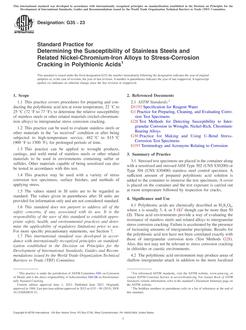
ASTM G125-00
1.1 This test method covers a procedure for measuring the threshold-limit conditions to allow equilibrium of combustion of materials in various oxidant gases under specific test conditions of pressure, temperature, flow condition, fire-propagation directions, and various other geometrical features of common systems.
1.2 This test method is patterned after Test Method D2863-95 and incorporates its procedure for measuring the limit as a function of oxidant concentration for the most commonly used test conditions. Sections 8, 9, 10, 11, 13, and 14 for the basic oxidant limit (oxygen index) procedure are quoted directly from Test Method D2863-95. Oxygen index data reported in accordance with Test Method D2863-95 are acceptable substitutes for data collected with this standard under similar conditions.
1.3 This test method has been found applicable to testing and ranking various forms of materials. It has also found limited usefulness for surmising the prospect that materials will prove “oxygen compatible” in actual systems. However, its results do not necessarily apply to any condition that does not faithfully reproduce the conditions during test. The fire limit is a measurement of a behavioral property and not a physical property. Uses of these data are addressed in Guides G63 and G94.
Note 1–Although this test method has been found applicable for testing a range of materials in a range of oxidants with a range of diluents, the accuracy has not been determined for many of these combinations and conditions of specimen geometry, outside those of the basic procedure as applied to plastics.
Note 2–Test Method D2863-95 has been revised and the revised Test Method has been issued as D2863-97. The major changes involve sample dimensions, burning criteria and the method for determining the oxygen index. The aim of the revisions was to alignTest Method D2863 with ISO 4589-2. Six laboratories conducted comparison round robin testing on self-supporting plastics and cellular materials using D2863-95 and D2863-97. The results indicate that there is no difference between the means provided y the two methods at the 95 % confidence level. No comparison tests were conducted on thin films. The majority of ASTM Committee G4 favors maintaining the D2863-95 as the backbone of G125 until comprehensive comparison data become available.
1.4 One very specific set of test conditions for measuring the fire limits of metals in oxygen has been codified in Test Method G124. Test Method G124 measures the minimum pressure limit in oxygen for its own set of test conditions. Its details are not reproduced in this standard. A substantial database is available for this procedure, although it is much smaller than the database for Test Method D2863-95.
Note 3–Warning: During the course of combustion, gases, vapors, aerosols, fumes or any combination of these are evolved which may be hazardous.
Note 4–Precaution: Adequate precautions should be taken to protect the operator.
1.5 The values stated in SI units are to be regarded as the standard.
1.6 This basic standard should be used to measure and describe the properties of materials, products, or assemblies in response to heat and flame under controlled laboratory conditions and should not be used to directly describe or appraise the fire hazard or fire risk of materials, products or assemblies under actual fire conditions. However, results of this test may be used as elements of a fire risk assessment which takes into account all of the factors which are pertinent to an assessment of the fire hazard of a particular end use. The standard has more applicability in this regard at predicting the fire behavior of materials and components that are close in size to the test condition, than for systems that are much different (for example: comparing a test rod to a valve seat rather than comparing a test rod to a house or a particle)
1.7 This standard does not purport to address all of the safety concerns, if any, associated with its use. It is the responsibility of the user of this standard to establish appropriate safety and health practices and determine the applicability of regulatory limitations prior to use.
Product Details
- Published:
- 11/10/2000
- Number of Pages:
- 9
- File Size:
- 1 file , 110 KB
- Redline File Size:
- 2 files , 200 KB

